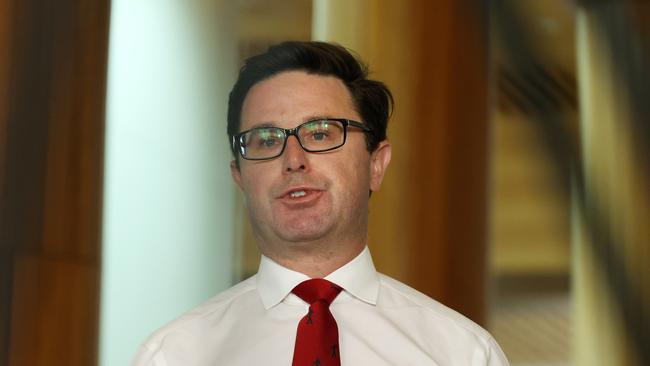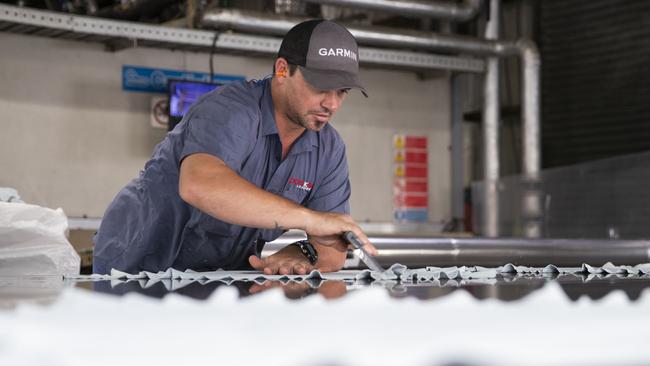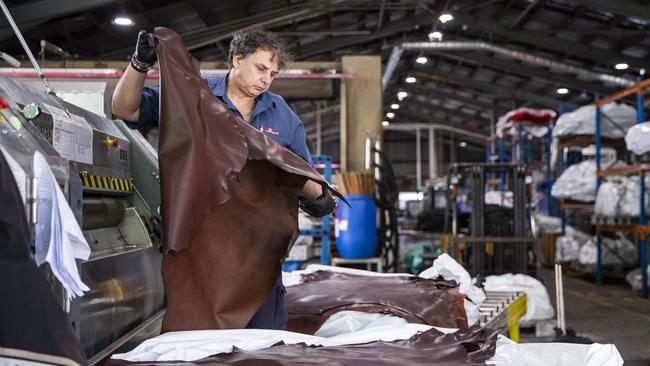US kangaroo skin ban ‘serious’ threat, warns leather industry
A century-old Queensland kangaroo leather export business warns a proposed ban on sales to the US would be disastrous for an industry just getting over Covid-19.
QLD News
Don't miss out on the headlines from QLD News. Followed categories will be added to My News.
A century-old Queensland kangaroo leather exporter has warned a proposed ban on imports to the US posed a looming “disaster” for an industry only just recovering from COVID-19.
Tannery industry veteran Lindsay Packer’s 130-year-old Packer Leather business, based north of Brisbane at Narangba, has survived attacks from activists trying to halt the kangaroo trade since the 1970s, even weathering a temporary Whitlam Government ban on kangaroo exports and an ongoing Californian ban on products containing kangaroo body parts since 2016.
But the controversial industry is now the target of a well-organised campaign by activists lobbying big brands, such as Nike, to quit using kangaroo leather in their sports shoes.
It has won support in Washington, with a bill proposing a US-wide kangaroo imports ban.
Mr Packer, 77, whose family business exports up to 20 per cent of its product to the US, says he is counting on the industry’s lobbying efforts to halt the bill, predicting it will cost jobs.

Introduced in the US House of Representatives in February and backed by both Democratic and Republican congressmen, the proposed Kangaroo Protection Act is targeting the use of kangaroo leather in soccer shoes (cleats) in the US - the world’s second biggest market.
It is backed by groups including the Center for Humane Economy, whose Kangaroos are not Shoes campaign opposes what it describes as the “largest land-based commercial wildlife slaughter in the world.”
According to a 2020 report by the Center, commercial shooters kill about two million kangaroos a year, including 400,000 joeys “bludgeoned to death or left behind to starve after their mothers are slain.”
“Being shot by a paid shooter who will hack off their heads and limbs, bludgeon their joeys to death and haul away their carcasses for processing seems particularly unsporting for a sporting manufacturer,” the campaign states.
The Kangaroo Industry Association of Australia is working to defeat the proposed ban with the support of federal Agriculture Minister David Littleproud and US ambassador Arthur Sinodinos, who is lobbying sponsors of the bill on the “real facts” of the kangaroo trade.

Mr Littleproud has accused activists of “disgracefully creating perverse animal welfare conditions by trying to ban kangaroo harvesting”
“If sustainable harvesting stops, kangaroos will potentially face an inhumane death of dehydration and starvation in drought,” he said.
“It’s disappointing politicians thousands of kilometres away think they can impose an uneducated view on Animal welfare standards in Australia.”
Center spokesman Wayne Pacelle hit back at Mr Littleproud’s criticisms, saying the “bashing in of the skulls of 400,000 joeys, taken from the slain mothers’ pouches, is the true international disgrace.”
“The industry knows that joeys will be orphaned by the slaying of their mothers, yet the commercial shooters are undeterred and go about it anyway,” spokesman Wayne Pacelle said.
“No other consumer product comes from such a massive, ruthless and merciless slaughter of native wildlife,” he said.
“Until Nike announces that it will stop sourcing kangaroo skins for its athletic shoes, there will be growing efforts by lawmakers and consumers to shut down the trade.”
Ban threat “serious”
Introduced into the US House of Representatives by Californian Democrat Salud Carbajal and Republican Brian Fitzpatrick, the Kangaroo Protection Act proposes banning the sale of kangaroo products across the US punishable by steep penalties of up to $10,000.
It has the support of 12 congressman, including two Republicans.
Only California, since 2016, has so far banned the sale of kangaroo parts, but Mr Carbajal wants to disrupt the imports on a wider scale over concerns it is unnecessary and cruel.
He said millions of kangaroos were dying a year so commercial shooters could profit from their skins, despite the availability of alternative fabrics “of a similar or better quality.”
“Commercial shooters kill two million kangaroos a year in Australia,” he said, in a statement.
“Many kangaroos survived the recent wildfires only to be killed to make shoes.”
KIAA spokesman Dennis King said it was taking the bill “very seriously,” with the US export market valued at $80 million.
About 1.5 million kangaroos are killed for commercial use a year, according to its figures.
Mr Packer, whose business supplies leather for the iconic Kookaburra cricket ball and Sherrin football, warned the bill could prove a “disaster” for business, which was only just recovering from a 50-60 per cent slump last year due to coronavirus.

“(The activists) are very noisy and they are dangerous, but if people read the facts, there’s not a problem,” he said. “The industry is sustainable.”
He said “cowboy” behaviour was not “not condoned by the industry” and the views of the activists were out-of-step with the rest of the population.
“If you took the housewives of Australia on a kill floor in an abattoir, see what their reaction would be,” he said.
“They wouldn’t like it but they’ll eat meat when it’s served up in a butcher shop.
“In this day and age there’s no reason not to follow a code of practice in the industry.
“Not everyone shooting in the bush is the industry. I’m saying our supply lines, especially right back there, are very much aware of the right practices.
“In other words, follow the code of practice, head shots, these sort of things...yes, you are killing an animal, but done properly, it’s humane.
“The industry has been operating under a code of practice for a number of years.
“There’s no mileage in the industry doing something that’s not going to protect things.
“Indirectly, harvesting balances things out and maintains the population that doesn’t cause other environmental problems.”
Kangaroo code
The National Code of Practice for the Humane Shooting of Kangaroos and Wallabies for Commercial Purposes explicitly sets out killing methods.
Commercial kangaroo harvesters must comply with the code as a condition of their licence or permit, it states.
Under the code, animals must be checked to ensure they are dead straight after being shot.
Shooters must pass a five yearly competency test, target kangaroos with a head shot, euthanise animals not immediately killed quickly and humanely and promptly kill any pouch young.
Pouch young must be euthanised humanely by decapitation, cervical dislocation, or a “concussive blow to the head” to cause blunt force trauma, depending on the age.
Cervical dislocation is a “method of euthanasia that involves stretching of the neck to separate the cervical vertebrae from the skull,” it states.
“Insensibility and death are due to direct damage to the brain stem or lack of blood to the brain,” it continues.
The code is published by Federal Government statutory authority AgriFutures Australia, but a disclaimer states “the Commonwealth of Australia gives no assurance as to the accuracy of any information in this publication” and “does not necessarily endorse the views” in the code.
The code was revised in 2020, attracting almost 5000 written submissions.
Many submissions on the killing of pouch young disputed research stating that marsupial young were not sentient and capable of feeling pain until developing fur and having their eyes open, arguing the claim was “barbaric and incorrect..in fact..outright evil,” a report by AgriFutures Australia on the development of the code says of the feedback.

The submissions argued decapitation and cervical dislocation “should be removed as acceptable methods of killing unfurred pouch young.”
Captive bolt gun and firearm headshots at point blank range were suggested alternatives.
A spokesman for the Department of Agriculture, Water and the Environment said the department “does not keep statistics on the number of joeys dispatched as part of the sustainable commercial kangaroo harvest.”
But he said commercial shooters preferentially targeted large male kangaroos, with males making up an average of more than 70 per cent of the annual commercial harvest across all species in all states.
Asked to explain the term “dispatched,” he said it meant “dealt with quickly and efficiently,” but clarified that “euthanised” was “more accurate and is the preferred term.”
Mr Pacelle argued such terms used by industry and the Government gave “false assurances” joeys were not suffering.
“The average person does not equate euthanasia and bashing the skull of a newly orphaned joey against a rock or the rear end of a truck,” he said.
“Bashing in the skull is death by blunt force trauma, and not anything like the administering of a barbiturate, such as sodium pentobarbital, when an animal is killed at a veterinary hospital or shelter as an act of mercy.
“The industry knows that joeys will be orphaned by the slaying of their mothers, yet the commercial shooters are undeterred and go about it anyway.”
The numbers
The Federal Government argues no long-term impact on kangaroo populations has been identified by state management agencies in more than 30 years of commercial harvesting.
That included during severe drought, a spokesman from the Agriculture department said.
He said kangaroos were “sustainably harvested under management plans approved under Australian’s national environment legislation, the Environment Protection and Biodiversity Conservation Act 1999.”
Government figures show there a population 42.76 million within commercial harvest areas in Queensland, New South Wales, South Australia and Western Australia across all species.
In 2018, the total harvest was 1.57 million macropods.
More than 750,000 of the kangaroos harvested were from Queensland - mostly eastern grey kangaroos.
A KIAA spokesman said: “As you would expect there is a lot of misinformation about the sustainable management of kangaroo populations in Australia including the fact that no threatened species are involved and it is a well-regulated and monitored industry in Australia.”
On the home front
For wildlife carers like Cienwen Hickey the futility of fighting to save rescued kangaroos while hunters are given the green-light by the Government to kill others is stark.
Ms Hickey, who has rescued kangaroos for two decades in rural Victoria, believes many Australians would turn against the lucrative kangaroo skin industry if they knew of the “horrible” practices propping up the industry.
She said the national code was not enforced by law.
“Australians are totally unaware of what goes on here,” she said.
“Most comments are made from farmers still living in colonial times.
“They will say: ‘What do you know, you latte sipping city dweller, about the country?’
“But it’s a story that needs total exposure in Australia because this is on our Coat of Arms.
“Australia is known as the country of the kangaroo. It’s unique.
“And they are being killed by the millions every year for leather. I feel it’s shameful.”
Ms Hickey said it could take $300 in milk powder to raise one orphaned joey to weaning age, only for millions of other kangaroos to be killed for commercial use.
She said arguments kangaroos were a pest were inaccurate, and questioned why animals such as deer, were not targeted for the pet food industry instead of the native kangaroo.
“We are overrun with deer. They are ruining the trees. They eat so much more than just grass.
“Why not kill them for pet food?”
“I’m absolutely 100 per cent convinced kangaroos are killed for their skins.
“That’s why the industry still exists.”
A federal agriculture department spokesman referred the newspaper to the State Government when questioned about whether the code was enforced, saying the states had responsibility for licensing harvesters.
Old foe
Opposition to the industry is far from new for Mr Packer, the patriarch of the Packer Leather family dynasty.
It had only just shifted its tannery to Narangba in 1973 when the incoming Whitlam Labor Government announced bans on the export of kangaroo hides to the US.
American importers at the time were buying about a million skins a year, according to a newspaper report at the time.
While domestic manufacturers could carry on canning kangaroo meat and using fur to make products at home, it would be years before the export ban was lifted.
It created long lasting problems for the Packer family.
Mr Packer recalls it took “quite a number of years” to woo back customers.
He said the fifth generation family business was less exposed than it is now (it currently exports anywhere from 10-20 per cent of its kangaroo product to the US), but still fears the impact should the US ban succeed.
“Indirectly, we have had anti-kangaroo (product) activists or whatever right back to the 1970s,” Mr Packer said.
“Every time there’s an Olympics there’s a problem,” he said – a reference to campaigns targeting the use of kangaroo leather in soccer shoes (cleats).
“That’s how activists run. You have people like PETA who work on the social media lobbying our customers, you know, the industry’s customers. They are running the vegan line at the moment.”

He said he was not opposed to the use of alternative material to leather, but was “against them using the leather industry’s terminology” by marketing it as vegan leather.
Mr Packer said the industry has been pushing back by exposing weaknesses in alternative products, such as the use of plastics in its production.
“If you look into that, that’s not as smart as they think it is,” he said.
Athletes such as cycling champion Dotsie Bausch and New Zealand soccer player Katie Rood were among those to write to Nike last year asking it to end the use of kangaroo skins.
“..this moral problem in your supply chain has never been more glaring as the
world grieves for the massive loss of life of kangaroos, koalas, and other distinctive Australian wildlife,” they wrote in an open letter.
Nike did not reply to the newspaper’s request for comment.
Originally published as US kangaroo skin ban ‘serious’ threat, warns leather industry


